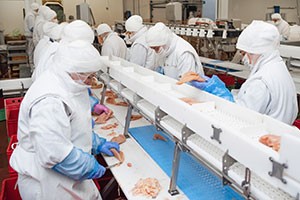Musculoskeletal Disorders (MSDs) in the Meat Processing Industry

An estimated half-million people are employed in the US meat processing industry. Safely working in this environment is important. One of the leading causes of workplace injury in the meat processing industry is musculoskeletal disorders (MSDs.) These occur as a result of:
- Repetition—performing the same motions repeatedly. The number of movements may be affected by the speed of the conveyer belt, or the number of workers available to do the job
- Forceful exertion—the amount of physical effort required to perform a demanding task, such as heavy lifting or hanging/rehanging meats, or to maintain control of equipment or tools
- Awkward postures—reaching above shoulder height, kneeling, squatting, leaning over a worktable, twisting the torso while lifting, maintaining a sustained posture for a long period of time, and using tools in a fixed position that place stress on the body
- Vibration—using vibrating, hand-held power tools can increase tension in the hands and arms
- Cold temperatures—can increase the risk of MSDs due to its effect on body tissue
There are multiple types of MSDs—tendonitis, carpal tunnel syndrome, osteoarthritis, fibromyalgia, bone fractures, and rheumatoid arthritis (RA). If not treated in a timely manner, MSDs can lead to serious pain and long-term injury. Fortunately, prevention is possible by following these practices:
- Know the risk factors
- Take regularly scheduled breaks to let your body rest
- Employers should implement training so workers can recognize MSD signs, and try to rotate workers between jobs to ease task demands
- If necessary, certain personal protection equipment (PPE) such as braces, wrist splints, and back belts may help reduce pain and intensity
OSHA has published guidelines for meatpacking plants on how to implement an effective ergonomics program to reduce MSDs.



